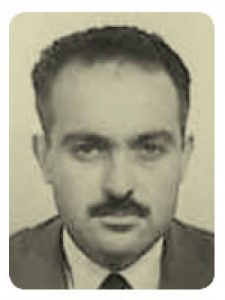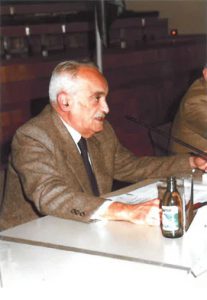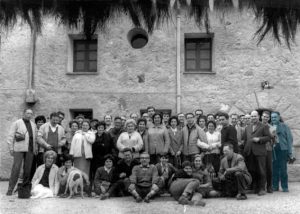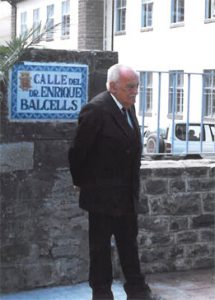
Dr. Balcells was born in Barcelona on 31 March 1922 into a noble family. He began his high school studies at the Maragall Institute of Barcelona and completed them on 1939 at the Sant Isidoro Institute of Seville, the city where his family had moved to given the political convulsions of the period due to the Spanish Civil War. Back in Barcelona on 1943, he graduated in Natural Sciences at the University of Barcelona with top marks. He was the main founder of the Pyrenean Center for Experimental Biology and one of the most distinguished zoologists in Spain during the postwar period.
Three lines of research
His research can be divided into three stages, as he said himself in a publication from 1992 titled “The scientific work of Dr. Balcells.” In the first stage he studied invertebrates and elaborated his doctoral theses on the biology of Haltica lythri subs. Ampelophaga under the direction of Dr. García del Cid. On 1950 he obtained his Ph.D. from the Complutense University in Madrid. During the second stage he was fully dedicated to the study of vertebrates, especially chiropters, a field where he obtained excellent international prestige. In the third and last stage, probably influenced by his nomination as Spanish president of the UNESCO’s MaB (Man and Biosphere) Committee, he was dedicated to the study of man and its influence on the biosphere. His activity was constant, he never stopped. He was permanently writing, doing field or organizational work.
Entomology
As an entomologist he worked at the Entomology Station of the National Institute of Agricultural Research in Madrid and at the Spanish Entomological Institute of the CSIC (Spanish National Research Council). He later worked at the Laboratories of Zoology and Animal Physiology of the Faculty of Science of the University of Barcelona, at the Institute of Applied Biology, and at the Department of Physiology and Biochemistry of the CSIC in Barcelona, were he began, in a pavilion adjacent to the former Balmes Institute (located next to Aribau street in the gardens of the University of Barcelona) his study of vertebrates. It is likely that his greatest influence as a scientist was professor Dottrens of the Geneva Museum, a center where he carried out numerous scientific stays. In the field of causal embryology and developmental mechanics in vertebrates he worked with Prof. Devillers, who taught comparative anatomy at the Sorbonne (University of Paris). Among his great teachers, Adolf Portmann also stands out.
Teaching
With regard to his work as an educator, his nomination as the Chair of Biology at the Technical Superior School of Industrial Engineers in Terrassa, a textile region at the time. When Dr. García del Cid passed away, he was appointed professor of Zoology (prochordates and vertebrates) at the University of Barcelona. Later, and related to his definite stay in Jaca, he was in charge of the subject of Zoology (chordates) at the University of Navarre, where he later taught Ecology, together with Dr. P. Montserrat. Between 1964 and 1967 he taught several doctorate courses at the University of Barcelona, and later at the University of Navarre.
Research
He founded the Pyrenean Center of Experimental Biology with venues in Barcelona and Jaca, both dependent of the CSIC, where he developed an intense research and organizational task. He directed a great number of doctoral theses, training many specialists in vertebrates, many of whom who are still active in the CSIC or in the university sphere, and donated, in life, part of his patrimony and the ethnological collection he created, to the city of Jaca. Part of the maintenance of the Pyrenean Center for Experimental Biology was the responsibility of Dr. Balcells, as well as the grants that allowed for the training of a great number of researchers. The city of Jaca, in gratitude, awarded him the maximum recognition, the “sueldo jaqués” and dedicated a street to his honor. This shows his splendid work of patronage. The Museum of Zoology of Barcelona incorporated many collections thanks to him.
Publications
He wrote some science popularization works, directed several doctoral theses and published over 300 scientific articles on zoology (vertebrates and invertebrates), ecology, biogeography and conservation. Many of them appeared in Spanish and international journals: Sinergia, Pirineos, Geographicalia, Bulletin de l’Institut Royal de Sciences Naturelles de Belgique, Säugetierkundliche Mitteilungen, British Journal of Herpetology, Bulletin de la Société zoologique de France, etc. He also directed the journal Pirineus between 1966 and 1984.
A man of great humanity
He was a man in the best sense of the word, not with regard to the life he carried out, which was very frugal and austere, but for his behavior towards others. Of deep religious beliefs, he tried to practice evangelic rules. He gave without expecting anything in return, both in a financial and scientific sense and was not miser in his knowledge, but shared it with all those around him.





